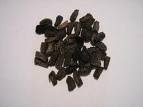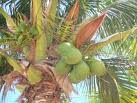Peaches have the Latin name Prunus because they were thought to resemble a plum and Persica because it was thought that they originated in Persia. However we now know that they originated in China where they have been cultivated for thousands of years and where wild peaches still grow. It is thought that they may have grown along the Chinese trade routes of the ancient world as traders threw away the peach kernels (which like almond kernels contain hydrocyanic acid which is toxic). The English word peach comes from the Old French peche. They were called Malus persica in the ancient world, meaning Persian apples. Peaches are members of the rose family of plants as is the strawberry. They are caller Aarhoo (pronounced aru) in Urdu.
 There are different kinds of peach and the white variety so loved by the Italians is a delicious one to use in desserts. Poached in wine with cinnamon they make very tasty ones.
There are different kinds of peach and the white variety so loved by the Italians is a delicious one to use in desserts. Poached in wine with cinnamon they make very tasty ones. The peach was known to the ancient Greek physician, Theophrastus in 329 BC and was in the writings of Confucius. In fact it is sacred to the Taoists and is the symbol of longevity. There is a legend from China which talks of a peach tree which belonged to the gods and which grew fruit once every 3,000 years if someone ate the fruit of this tree they were assured of virility and immortality. The peach is a symbol of longevity in China and gifts of peaches or decorative items with the peach motif on them are highly valued.
Peaches are high in fibre and can be used as part of a weight loss diet, as they can be eaten as snacks and suppress the appetite. There is now the Saturn variety of peaches which is a flat peach, sometimes referred to as the doughnut peach, which has gained in popularity in Britain since 2004 mainly because it can be eaten without being too messy. The flesh doesn’t cling to the stone, and as it is flat, (rather like the flying saucer shape of the popular imagination) you don’t tend to get juice all over you and have to resort to licking parts of your anatomy. These have not been genetically modified as you might be forgiven for supposing, but have been grown in China since the 19th century.
Peaches come in a variety of colours as well as shapes and may have white, yellow, red, pink or orange flesh. They are rich in vitamins A and C and also contain some B-complex ones as well as E and K. As for minerals, they are rich in potassium, and also contain iron, phosphorous, magnesium, calcium, selenium, manganese, copper and zinc. They have anti-microbial and antioxidant properties and may inhibit cancerous growth and reduce the risk of certain cancers, although trials are on-going.
In the Indian subcontinent peaches and leaves and bark are used for a variety of illnesses including anaemia, asthma, gall bladder and kidney stones, bronchitis, constipation, dry coughs, gastritis, high blood pressure and poor digestion.
Peach leaf tisane is given to get rid of internal parasites and for coughs including whooping cough and it is also supposed to be good for bronchitis as it has expectorant qualities. To make peach leaf tisane, take 1 oz dried peach leaves to 1 pint boiling water. Pour the water over the leaves and allow to steep for 15 minutes, then strain and drink. Flavour with honey if necessary. A tisane can also be made from ½ oz of dried bark to a pint of boiling water as in the leaf tisane. Peach leaves and flowers can be distilled to make cordials and peach wine can be made from the fruit. The leaves and bark have sedative, expectorant and diuretic qualities. In Italy people used to place a peach leaf on a wart and then bury the leaf. It was believed that as the leaf rotted so the wart would drop off.
You can make an infusion of peach flowers which was reckoned to be good for jaundice, and which has purgative properties. The best time to harvest the leaves is early summer, while the bark should be stripped from young trees and then sun-dried, taking it in at night before the dew falls.
 The 16th century English herbalist John Gerard grew peach trees in his garden, and Culpeper recommended the powdered leaves for staunching blood flow from wounds and to close them. He also suggested using the sap from the cut tree mixed with coltsfoot, sweet wine and saffron for “coughs, hoarseness and loss of voice.” He went on to say that this was also good for the lungs as it “clears and strengthens” them and “relieves those who vomit and spit blood.” Finally he recommends that the bruised kernels should be boiled in vinegar “until they become thick and applied to the head, it marvelously causeth the hair to grow again on any bald place or where it is too thin.”
The 16th century English herbalist John Gerard grew peach trees in his garden, and Culpeper recommended the powdered leaves for staunching blood flow from wounds and to close them. He also suggested using the sap from the cut tree mixed with coltsfoot, sweet wine and saffron for “coughs, hoarseness and loss of voice.” He went on to say that this was also good for the lungs as it “clears and strengthens” them and “relieves those who vomit and spit blood.” Finally he recommends that the bruised kernels should be boiled in vinegar “until they become thick and applied to the head, it marvelously causeth the hair to grow again on any bald place or where it is too thin.” The recipe below for the Bellini cocktail is the original one first concocted in Harry’s Bar in Venice by Giuseppe Ciprianti who was inspired so it is said, by Bellini’s art. It’s best with white peaches but any variety will do.
Ingredients
Serves 2
1 white peach, peeled and blended
½ bottle champagne or sparkling white wine
2 peach balls
Method
Put the peach pulp in a champagne flute and add champagne (originally Italian Prosecco was used).
Put a melon ball in each flute and let it sink to the bottom.
If you want to add a measure of crème de peche and a dash of peach bitters to each flute this will be closer to the Bellini that you will be served in a cocktail bar.
This has Taste and is a Treat.






















